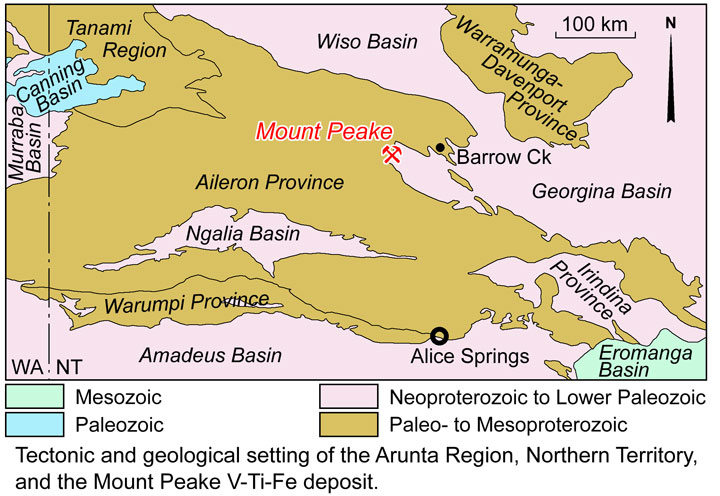|
Mount Peake |
|
|
Northern Territory, NT, Australia |
| Main commodities:
V Ti Fe
|
|
 |
|
 |
 |
Super Porphyry Cu and Au


|
IOCG Deposits - 70 papers

|
All papers now Open Access.
Available as Full Text for direct download or on request. |
|
 |
The Mount Peake vanadium-titanium-magnetite deposit is located 235 km NNW of Alice Springs and 65 km WSW of Barrow Creek in the Northern Territory (#Location: 21° 39' 42"S, 133° 16' 44"E).
The depost is hosted by a mafic intrusion within the Aileron Province of the Arunta Region, in an area long regarded as prospective for nickel-copper and platinum group minerals. Previous drilling of magnetic anomalies aimed at finding nickel mineralisation in 1982 and 2006 intersected magnetite-rich gabbro at Mount Peake. TNG Limited became aware of the vanadiferous magnetite rich gabbro during a study of historic data and drill core. In subsequent drilling from 2008 they outlined a magnetite-bearing gabbro body containing high-grade vanadium, titanium and iron.
The intrusion hosting the Mount Peake deposit is situated in the northeastern Aileron Province, but also intrudes the basal section of the overlapping Georgina Basin to the east. The Aileron Province is largely composed of Paleoproterozoic sedimentary rocks that range in age from 1860 Ma to 1740 Ma, dominated by turbiditic siliciclastics, with lesser carbonate and volcaniclastic rocks. In the north of the Province, these rocks have been extensively intruded by 1820 to 1790 Ma granites of the Stafford Event resulting in high temperature, low pressure metamorphism of the sedimentary sequence to amphibolite facies in the Mount Peake area. The Georgina Basin is locally represented by the Ediacaran 560 Ma Central Mount Stuart Formation, composed of lithic, arkosic and quartzitic arenite, siltstone, dolostone and minor basal conglomerate.

The mafic intrusion at Mount Peake is interpreted to be related to the widespread 510 Ma Kalkarindji Event large igneous province. It is part of a regionally extensive complex of mafic sills distributed over an area of 200 km2. The Mount Peake layered sill is >250 m thick, predominantly composed of olivine gabbro. A 400 m wide, flat-lying channel-like like intrusion occurs in the upper preserved section of the sill. The base of this channel is occupied by the Footwall Mixed Gabbro zone that pinches out towards the sides and is at least 25 m thick in its centre. This is overlain by the up to 150 m thick ore bearing Magnetite Gabbro, which also pinches out against the steep walls of the channel. This gabbro generally contains ~40% cumulate magnetite that is intimately associated with the vanadium and titanium mineralisation. The uppermost unit is a Coarse Gabbro which extends to the base of the overlying thin (<20 m) transported cover. It has a preserved thickness of at least 25 m thick, but occurs as a laterally more extensive cap that laps onto the footwall olivine gabbro.

The mineralised Magnetite Gabbro extends over a north-south oriented length of 2100 m, width of 400 m and ~120 m thickness. An envelope of >0.1% V2O5 includes both the Footwall Mixed Gabbro and Magnetite Gabbro, while the >0.2% V2O5 closely outlines the Magnetite Gabbo. The enclosed of >0.4% V2O5 is restricted to the upper two thirds of the Magnetite Gabbro.
The current total JORC compliant Mineral Resource is estimated to be (TNG Minerals website, 2017):
Measured+Indicated+Inferred Resource - 160 Mt @ 0.28% V2O5, 5.31% TiO2 and 22.81% Fe,
including
Measured Resource - 118 Mt @ 0.29% V2O5, 5.48% TiO2 and 23.64% Fe with 8.18% Al2O3 and 32.81% SiO2.
The most recent source geological information used to prepare this decription was dated: 2015.
This description is a summary from published sources, the chief of which are listed below.
© Copyright Porter GeoConsultancy Pty Ltd. Unauthorised copying, reproduction, storage or dissemination prohibited.
Mount Peake
|
|
|
|
Porter GeoConsultancy Pty Ltd (PorterGeo) provides access to this database at no charge. It is largely based on scientific papers and reports in the public domain, and was current when the sources consulted were published. While PorterGeo endeavour to ensure the information was accurate at the time of compilation and subsequent updating, PorterGeo, its employees and servants: i). do not warrant, or make any representation regarding the use, or results of the use of the information contained herein as to its correctness, accuracy, currency, or otherwise; and ii). expressly disclaim all liability or responsibility to any person using the information or conclusions contained herein.
|
Top | Search Again | PGC Home | Terms & Conditions
|
|